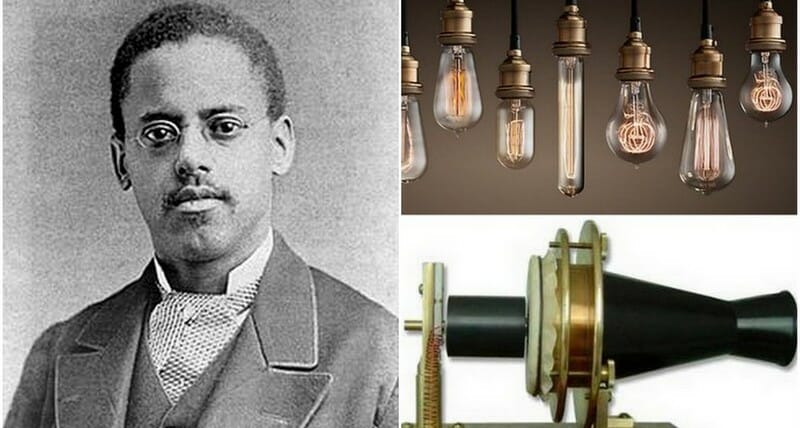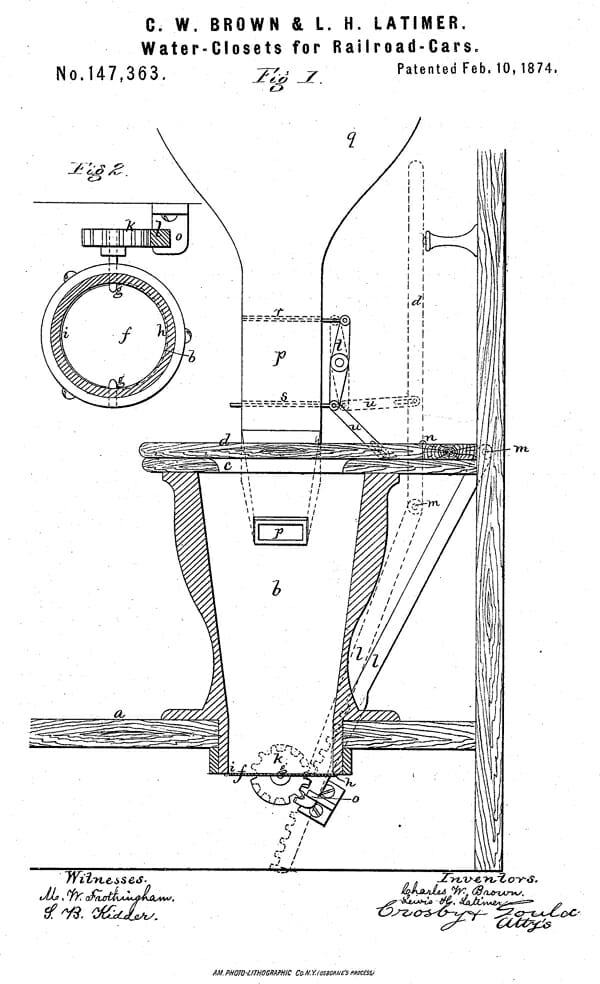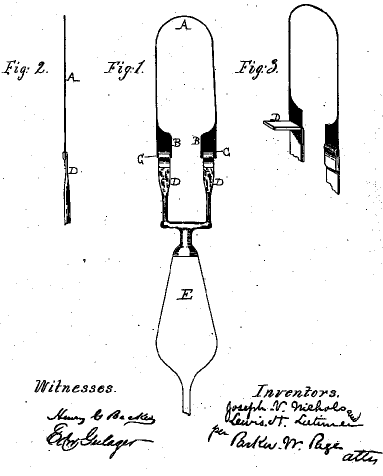African American Lewis Howard Latimer invented the Carbon Filaments Light Bulb (Electric light bulb) according to Africa Giant Exclusive which are present in people’s homes, offices, and streets today. Lewis invented the “Process of Manufacturing Carbons”. Without this process, light could not be emitted using electricity. But he obtained a patent for inventing the “Electric light” before he did with the “Process of Manufacturing Carbons”.
Lewis Howard Latimer invented the components of the Carbon Filaments Light Bulb. The African Giant was born on September 4, 1848, in Chelsea, Massachusetts. The son of George and Rebecca Latimer, he was one of seven children. His father was a fugitive slave who had escaped to the North before the outbreak of the Civil War. In 1865, at the age of 17, Latimer enlisted in the United States Navy and served for two years. After his discharge, he worked as an office boy for a patent law firm in Boston. It was there that he first became interested in inventing.
In 1874, Latimer invented a process for manufacturing wood-pulp paper, which was used by toilet paper companies for many years. He also developed a method for mass-producing carbon filaments for use in light bulbs. These inventions led to his being hired by Thomas Edison as part of his research team. Latimer’s most important invention was the development of a process for manufacturing the carbon filaments used in light bulbs. This innovation made electric lighting more affordable and widely available. Latimer’s work helped to make electrification a reality in homes and businesses across the country. While Edison is often credited with inventing the light bulb, it was actually Latimer’s invention.
Before Latimer’s invention in 1880/1881, several scientists believed that light could be generated through electricity and therefore, had attempted for many years the use of woods and threads to emit light or generate incandescence light without success.
Early attempts at creating electric light were largely unsuccessful. Materials like bay wood, cedar, bamboo, and thread were used in an attempt to create a filament that would emit light. However, these materials quickly burnt out when exposed to electricity. This made them impractical for use as a long-term lighting solution. In addition, these materials were also quite expensive to produce. As a result, early attempts at creating electric light were largely unsuccessful. It wasn’t until the development of the incandescent light bulb that electric light became a practical and affordable option for everyday use.
See also: At only age 14, Tony Hansberry II invented a surgical stitching device
While the early attempts were able to create sparks and flashes of light, they were unable to produce a sustained light source. This changed in 1880/1881 when Latimer invented the incandescent light bulb. Using a filament made of carbonized thread, Latimer was able to create a bulb that emitted a steady, bright light. His invention revolutionized lighting and paved the way for further discoveries in the field of electrical engineering.
An African Giant Latimer had a natural talent for engineering, and his skills were in high demand by companies working on electric lighting. He was hired by one of the leading firms in the field, and he quickly rose to become an expert on incandescent lights. His work helped to improve the efficiency of lightbulbs, and he also patented several key inventions. Latimer’s expertise was widely recognized, and he consulted on projects all over the world. He continued to work on improving lightbulb technology until his death in 1931. Thanks to his contributions, electric lighting became more affordable and widespread, changing the way we live and work.
This young talent was determined to create the first light in the world that uses electricity but he soon realised that it was impossible to emit light without having to know the processes involved. Latimer knew this was going to take understanding of how electricity works and the science behind it. To gain this understanding, Latimer spent countless hours reading scientific texts and conducting experiments. His hard work paid off; in 1881, he patented his design for an improved electric lamp.
After much study, Latimer figured out what he would need to create a light bulb, from the base materials to the top-level materials. He first had to invent the “Process of Manufacturing Carbons”. Without this process, light could not be emitted using electricity. The Process of Manufacturing Carbons was an extremely complex one but essential in generating light.
The “Process Of Manufacturing Carbons” for electricity and light requires the first start with a base material. Latimer took the first step to creating the “Carbon Rods or “Carbon Fiber Filament”. These are made by taking a small piece of metal and attaching it to the end of a long wire. The metal is then heated until it turns into carbon. This carbon is then wrapped around a mandrel, which gives it its shape. Once the carbon has cooled and hardened, it is ready to be used in a variety of applications.
Carbon filaments are an essential component of many types of lights, including LED and fluorescent bulbs. In addition to their use in lighting, carbon filaments can also be used in batteries and conductive materials. As a result, this simple manufacturing process has a wide range of real-world applications.
Once the “Carbon Fiber Filament” is created, they are put into an oven and heated until they reach their target temperature. At this point, they are ready for use in the process of emitting electric light. Latimer filed for a patent on February 19, 1881 for his invention of the “Process Of Manufacturing Carbons” but unfortunately will not get the patent until a year later on January 17, 1882. As the “Carbon Fiber Filament” was achieved, he would then go ahead with the next step of generating light using the Filament, by connecting the carbon fibre filament with electricity and light was emitted.
The modern light bulb is a marvel of engineering, and it all starts with the incandescence of a continuous strip of carbon. This carbon strip is secured to metallic wires and enclosed in a sealed, transparent receiver. The receiver is then placed under a vacuum, which helps to prevent the escape of any gasses that could interfere with the light bulb’s operation. Finally, the whole assembly is encased in glass, which protects it from the elements and helps to diffuse the light. Thanks to this simple but elegant design, light bulbs are able to produce a steady, bright light that has revolutionized the way we live.
These fiber filaments were extremely durable and could withstand the heat from the electricity. Additionally, they were much more affordable to produce than other materials. This means every household could afford an electric light bulb.
On September 13, 1881, Lewis Howard Latimer was granted a patent for his invention of the electric light. This followed his earlier invention of the “Process Of Manufacturing Carbons” using carbon fiber filament. The electric light was a major breakthrough in lighting technology, and it quickly began to replace candles and oil lamps as the preferred source of illumination. Thanks to Latimer’s inventive genius, the world was forever changed.
Latimer’s electric light bulb was an instant success, thanks to its simple design and low cost. It quickly became popular in homes, businesses and streets all over America, lighting up everywhere. But the genius did not stop there, he also went on to invent more in order to advance his inventions relating to the electric light bulb.
As more major cities began wiring their streets for electric lighting, Latimer was dispatched to lead the planning team. He helped to install the first electric plants in Philadelphia, New York City and Montreal and oversaw the installation of lighting in railroad stations, government buildings and major thoroughfares in Canada, New England and London.
A follow-up invention to the carbon fiber filament, Latimer advanced the Light bulb by creating a Carbon Arc lighting, an advancement on his previous invention of emitting light. This more advanced work on the carbon arc lamp was an important stepping stone in his journey to create a more efficient light bulb. The design of the lamp was based on his previous invention of the carbon fiber filament. By using an arc of electricity to heat the carbon rods, Latimer was able to create a more intense light. This design would eventually lead to his development of the incandescent light bulb. The carbon arc lamp was a major improvement over previous lighting designs, and it paved the way for Latimer’s most famous invention.
See also: Arthur Zang invented Africa’s first touch-screen medical tablet: Diagnose people with heart disease
The carbon arc lamp is a type of electric lamp that uses an arc between two carbon rods to produce light. The arc is created when the rods are touched together and then drawn apart, and the current flowing through the arc heats it to a high temperature. The resulting light is very bright, making it useful for applications such as searchlights and movie projectors. However, the carbon arc lamp also has some disadvantages. For example, it produces a lot of heat and fumes, and is therefore not well suited for use in enclosed spaces. Additionally, the carbon rods must be regularly replaced, which can add to the operating costs of the lamp. Despite these drawbacks, the carbon arc lamp remains an important part of many electrical systems.
Carbon Arc Lamps are used for many purposes, including street lighting, mining, and motion picture production. They are also used in scientific research, because their intense light can be used to study materials in detail. There are several different types of carbon arc lamps. The most common type is the limelight lamp. This type uses a pair of lime-burning jets to produce light.
President Joe Biden highlighted the importance for Black Americans to be recognized for their contributions to society, and that America needs to do better in schools by teaching the African/ Black contributions to world civilization during a community meeting in Kenosha, Wisconsin, the United States on Sept 3, 2020. While making his speech, he stated that a Black man invented the light bulb. He also urged everyone present to continue working together to create such change in the society.
The Black man President Joe Biden referred to; Latimer, went on to finalise his inventions relating to the light bulb by inventing the “Supporter for electric lamps” which he patented on March 21, 1882.
African Giant Latimer was a genius inventor who changed the way we see light. His electric lamps were revolutionary, and his hard work paid off, as everyone can all enjoy a home, workplaces and streets with an Electric light bulb, Thanks also to Latimer for making electric lighting more accessible and efficient for everyone.
Among Latimer’s other inventions includes the “Improvement in water-closets for railroad-cars” which was patented on February 10, 1874. He also received a patent for his invention of “Apparatus for cooling and disinfecting”, on January 12, 1886.
Latimer invented the Carbon Filaments Light Bulb which are present in people’s homes, offices, and streets today. His inventions are considered one of the most important inventions in history, His ground-breaking invention of the Carbon Filaments Light Bulb, revolutionized modern lighting. Latimer also painted, played the flute, wrote poetry and plays. He settled in Flushing, New York, and lived there until his death in 1928.
More African inventors >>














